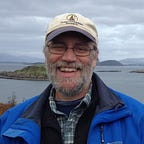Easter Island, Hard Work and Good Cheer for a Changing Climate-Challenged World
The anchor chain clinked and clanked through the hawsehole on the Dutch tall ship Oosterschelde until the large anchor set into white coral sands turned periwinkle blue by clear ocean waters. At first light, the volcanic mountains of Rapa Nui (Easter Island) had stepped out of the mist, turning from blue to green as they loomed larger on the horizon.
Sailing from the North and due to high winds from the West, we were directed by the port authorities away from the town on the Western shore. Rapa Nui is shaped like a large triangle. The only town, Hanga Roa, exposed and without the protection of a harbor, takes the brunt of the Westerly winds. We approached a cove sheltered by high cliffs along the Northeast bend of the island. Anakena, the island’s only sandy beach, is where the first people landed. Here, we found flat waters harbored from the wind and waves.
Seven Moai statues turned their backs on us. Among the carefully cut and tightly fitted large stones forming the platform beneath the Moai was an old Moai head in a horizontal position looking our way. More than 2,000 miles from the nearest shore, the people of this far-flung land demonstrate remarkable determination and tenacity to overcome challenges, create art, and prosper.
